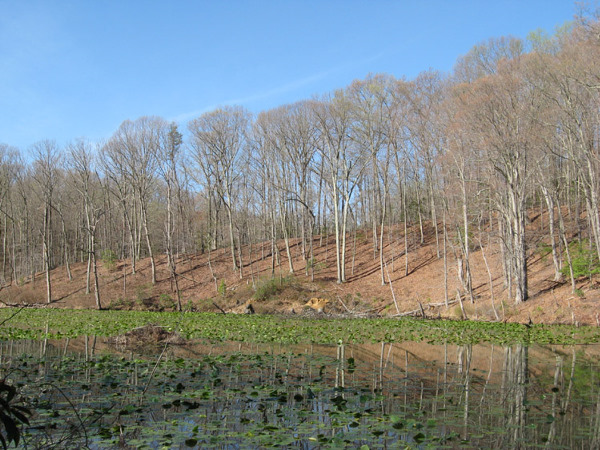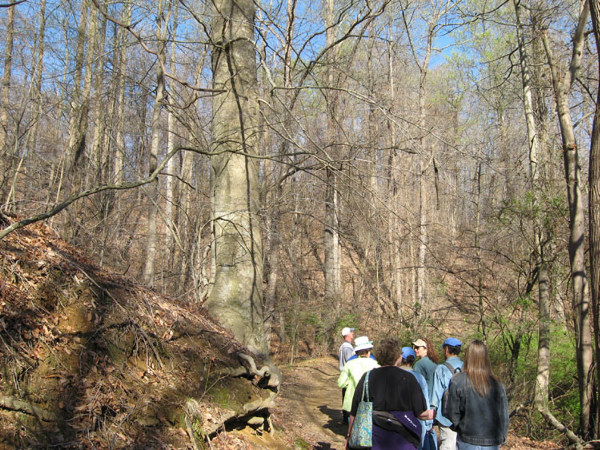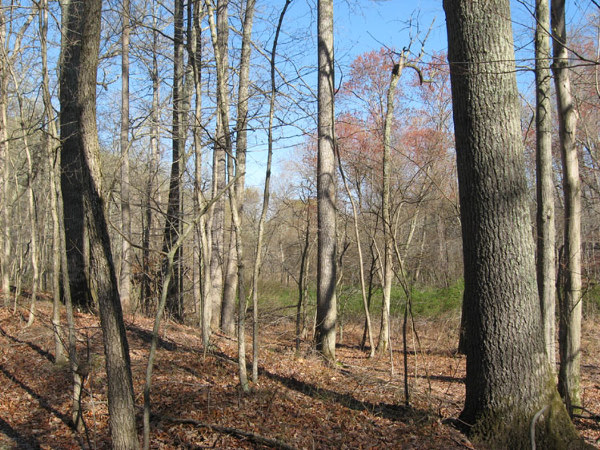This report covers my first
visit to the Bacon Ridge Conservation Area
in Crownsville, Maryland. This area is not yet an official
"park" -
while it is thanfully protected, it isn't really open to the
public
yet. I believe that this region was one of the areas in which
the late
Colby Rucker performed tree surveys in this part of Anne Arundel
county: I can see what drew him to this place since it is
beautiful.
Bacon Ridge / Scenic Rivers Land Trust Park: This park as of
2009 is
neither finished nor open to the general public regularly. It is
located not far from the Renaissance Faire in Crownsville
Maryland,
off of Generalís Highway. Getting to the park is currently a
strange
experience since one must drive down a small path past the ruins
of
old buildings that were once part of a state or county mental
hospital: most of the park land at one time belonged to the
hospital,
but it was never developed, thankfully. A couple of times a
year, the
park is opened to the public, though the events tend to attract
mostly
those who are truly interested in a walk through bushwhacked,
unpaved
trails Ė you even have to sign a disclosure form since the park
is, in
many ways, still wild. Currently, the Land Trust owns about 600
acres
that form the core of the park, with other plots of adjacent
land
being added, as they are able to do so. Once the boundaries are
established, paving the trails (or at least stabilizing them so
they
are no longer vulnerable to erosion) and adding an official
parking
lot and entrance road will be the next steps.
The trip through this park (which has an impressive mix of
terrain
features and a good variety of trees) starts by crossing over
I-97 on
large foot bridge until one reaches a flat field that slopes
upward to
tree-topped hills, while a trail spirals downwards past the base
of
the hill. Our birding group of about 10 people followed that
trail
downwards until we reached a marshy area. Traversing this region
was
difficult since it was a shoe-sucking, muddy swamp (this area is
a
prime candidate for a footbridge in the future to keep shoes dry
and
the land from being trampled.) After crossing the swamp, with
plenty
of stops to look for various interesting birds, we crossed over
a
small stream and started heading upwards. After a bit, we
crossed
another small stream while carefully avoiding the poison ivy
that
unkindly covered the trunks of the trees one would normally use
as
handholds for the small stream crossing, and we then started a
real
climb up the hillside.
Once we traveled up the hills a good distance, we got a
better view of
the park as a whole: off to the right was a steep drop down to
more
wetlands, while to the left the rest of the hill rose up above
us. We
passed through this type of terrain for a while, past some
thickets
that were great homes for many more birds, until we eventually
reached
a fork in the road. A huge tulip poplar had cracked apart and
crashed
onto one of the paths, but we wouldnít have to scramble over
that
until the return trip. We took the right hand path that lead us
around
a few more bends and eventually downhill until we reached the
beaver
pond.
The ďpondĒ is large enough to be a small lake: itís surface
was smooth
and tranquil and native water lilies covered it Ė these plants
flower
in June, which must be an amazing sight to see. We did some more
bird
watching here and saw a good variety of birds (I canít recall
the
names of everything we saw, but I did hear a wider variety of
bird
calls in this park than Iíve heard in any other park.) We then
went
around another corner to another park of the beaver pond to see
the
actual beaver dam. While there, we also spotted a huge turtle Ė
I was
told it was either a red-bellied turtle or a snapping turtle.
Either
way, it was the ďking of the pondĒ for sure!
We were running a bit late at this point, so we started to
ascend the
other side of the hill to head back to the starting point. We
rounded
another bend that provided a good overlook from the hillside
down into
the rather steep valley: thereís a huge beech tree here that is
one of
the largest Iíve ever seen in the wild. After that, we reached
the
fallen tulip tree and retraced our steps through the wilds back
to the
start.
Forest Composition: The forest here is an interesting mix of
upland
and lowland species, often growing in rather close proximity to
each
other. Oak trees of various types (red, white, chestnut, etc.)
were
very common, and some reached a good size. Tulip trees were
reasonably
common as well, and as always seems to be the case with this
species,
they could grow to huge proportions. American beech trees were
mixed
in with the other trees, including some beech-tulip poplar
mixes,
which is a rather unusual mix since beech trees normally grow in
higher, drier environments than tulip poplars. Some of the beech
trees
have reached very respectable sizes. Sweetgum trees grew in
clumps in
many regions, their presence given away by their spiky seed
balls. Iím
sure that there were some hickories in the mix as well, though
they
were hard to pick out from all the other trees. Maples trees
grew here
and there as well, and the park had a few conifers, but not
many.
Sycamore trees were oddly absent from the parts of the park that
we
visited: I didnít see more than a few of them, and none of them
were
very large. The park guide who lead our group told us that
certain
parts of the park were once known as good areas to harvest
chestnuts
many decades ago, so there may still be some American chestnuts
lurking in some parts of the park, but the guide didnít know of
any
mature trees, so they are probably just stump sprouts as best.
Hereís a weblink to the Scenic River Land Trust:
http://www.srlt.org/events.shtml#walk
They are a very dedicated group and I truly hope that this
park
achieves its great potential and thus becomes the largest and
probably
least altered by humanity park in Anne Arundel county.
I've have some photos that'll be passed along to the
webmaster so when
this article is posted to the website, they can be included.
In short, I highly recommend a visit to this park during one
of the
"Walk in the Woods" events, and especially when the park is
eventually
open to the general public.
 Beaver Pond
Beaver Pond

Group Shot with large beech

Scattered big trees